Route 1 (Iceland)
road in Iceland
Route 1, also known as the Ring Road (Icelandic: Þjóðvegur 1 or Hringvegur), is the main highway that encircles Iceland, connecting all of the island nation's major towns, including the capital city Reykjavik.
- This article is about the main highway in Iceland. For the Australian ring road, see Highway 1 (Australia)
Travelling along the Ring Road is quintessentially a staple for tourists in Iceland as it crosses landscapes one does not see often in continental Europe: white glaciers and blue icebergs, towering fjords and mighty waterfalls, smoky craters and dormant volcanoes, and for the lucky few: glowing auroras.
Understand
Route 1, also known as the Ring Road, is the major highway in Iceland, connecting Iceland's largest towns. Finished in 1974, it is 1,332 km (828 mi) long and goes through the island nation's assorted topographical features: fjords, mountains, flat lands. As well as the economical route for shipping items cross-country and to the smaller communities, tourists also don't want to miss out the opportunity to venture along the road to see the exceptional beauty of attractions that the ring road pass through. You may remember some of these sights from your favourite films.
Although it practically takes only 12 hours to drive along the road non-stop, avid travellers circumnavigate the island nation for between one and two weeks depending on the season, stopping by attractions directly adjacent to the highway or with a slight detour. Those that do not have much time, can still make a day or a half-week trip from Reykjavik to either the southern or western half of the island. The Golden Circle, a popular day trip from the city, is a smaller ring route that despite the furthest attractions being only 80 minutes away from Reykjavik, still provides some of the most enchanting natural features of the country, including mountains, a waterfall and a geyser.
As this is the only road connecting east to west in Iceland, visitors should take precautions when crossing the country, especially in non-populated areas. The road is now (after a routing change in East Iceland) almost completely paved with a single remaining gravel section on the shores of Berufjörður fjord in East Iceland, between the towns of Djúpivogur and Breiðdalsvík. Akureyri to Egilsstaðir is regarded as the most remote parts of the Ring Road and is commonly closed at times in winter. The roads are in good condition so getting around the country safely is easy in the summer.
Some of the sights listed in this itinerary are part of a smaller ring route, the so called Golden Circle, a day trip from Reykjavík.
Get in
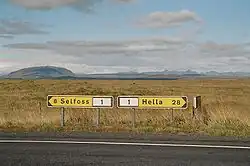
For visitors from abroad, there are in practice two ways for getting in. If you wish to bring your own vehicle, Smyril Line has a weekly sailing from Hirtshals, Denmark to Seyðisfjörður at the eastern end of the country. Otherwise, fly into Keflavík International Airport like most visitors do, and rent one there.
Of course if that vehicle is a bicycle, it can probably be transported on board your plane for an extra fee.
Talk
Even though Icelandic is the official language of Iceland, it is easy to get by in English as virtually all locals are fluent enough to at least start a conversation. Your national park rangers, guides and camp rangers are also helpful in at least explaining the basics in English. Many of the websites, exhibitions and explanations of an attraction are in both Icelandic and English. Visitors who might need help from each other may also be approached in English.
Prepare
There are many videos on YouTube that can prepare you well for a road trip around Iceland. If you're too lazy to watch them, just know this: whenever you come upon something unexpected, slow down. Or maybe even stop.
The website of the Icelandic Road Administration provides detailed information about overall road conditions, temperature, wind speed and direction and the traffic density almost in real time and also history for the past 48 hours.
While there is no charge to enter the National Parks, the cost of parking may exceed kr 2000 per day. Parking on the highway to avoid the parking fee is dangerous for your car and for other drivers.
The most important thing to bring is the right outfit for the weather and most importantly, cameras. While bringing professional photography equipment is recommended for the aficionados, it has to be convenient enough to be carried even for a short hike, as you will do plenty of them. Have some extra protection for them from extreme weather.
Drones are not allowed to be flown above 120 m, above people, in National Parks and most other attractions in which the ban is indicated; even then, they must be in sight of the controller at all times and it might be difficult to fly them during the high winds. They must be labelled with your name, address and telephone number.
Accommodation
.jpg.webp)
Campgrounds can easily be found along the road, either next to it or with a slight detour. They range from fully-equipped (hot showers, washing machines, cooking facilities) to farmers' fields with a cold-water tap. On average they cost at least kr 1000 per person per night, with discounts for children. Campers or cars that bring tents may stay there. While many of them generally open only from spring to early fall, be sure to wrap up as even the summer nights are cold. Although campgrounds are never full, this trend might change as more tourists means fewer empty spots, especially in summer. As most campgrounds only accept walk-ins (i.e. no reservations), one can simply walk up to the reception and then be directed to a free spot. When the receptionist is not present, one may set up camp and report to the reception in the morning.
Wild camping is no longer allowed. All campers, regardless of whether they are using tents or a camping van, must stay overnight only at designated campgrounds or with written permission from land owners on which ground you are staying. A list of campgrounds can be found here.
Hostels and hotels may be found at some of the major tourist attractions and towns. Whilst plentiful, they are expensive and fairly basic: one room can cost more than kr 7,000 per night.
Driving
See also: Winter driving, Driving in Iceland.
Any car will work if one chooses to stay along the road and detour not too far away; A 4x4 is compulsory for many of the interior and roads designated with the letter F. This is not just a legal requirement, the F roads are impassable with an ordinary vehicle. While driving in summer is pleasant and relatively flawless, you will need to be flexible if driving in winter as blizzards are known to shut down the road for up to 24 hours and your mileage may be lower after driving on snow and ice.
Camper vans are also popular for providing a place to sleep, but they must be parked only at designated campgrounds for overnight stays.
Seat belts must be worn by all passengers at all times. Headlights must be on at all times. Off-roading is strictly forbidden. If you wish to take a picture of the gorgeous scenes along the road, do not stop on road shoulders; instead find a pull-out, a designated parking area (blue sign with a white 'P'), a picnic area, or a farmer's road.
For most of its run, the road has one lane in each direction. In Reykjavik, there are two lanes in each direction. Bridges outside towns will often have only one lane, in which the first car arriving has a right of way (think of it like an all-way stop junction). The further away from town you go, the less cars you will see, often even none at all for an hour.
Make sure to fill up your fuel tank until full whenever you have to do so. In the rural sections, it is safely assumed to fill up at the first fuel station you see. Fuel costs at least kr 200 per litre in Reykjavik and more elsewhere. Payment can be made by cash and major credit cards, although the former may not always be accepted at unmanned fuel dispensers. A safe bet would be to use prepaid fuel cards or discount cards, which can be bought before the road trip at the respective brand's fuel stations or from your rental car provider. The most widely available fuel stations are provided by the brands N1 and Skelljungur and Orkan. Generally, expect to spend at least kr 30,000 for the complete trip.
Speed limits are 90 km/h in rural areas, 80 km/h in gravel roads, and 50 km/h in urban areas; unless indicated otherwise. Speeding cameras are abundant and violators would not go away without paying at least kr 100,000. It is your responsibility to adjust your speed during changing weather conditions. Challenging parts of the road are indicated with blue speed limit signs.
As the weather in Iceland can change often only in hours and with extreme differences in sunshine hours throughout the year, visitors should plan accordingly on what attractions they would like to see and how long it takes to get there. Some attractions are seasonal only, while a snowstorm may force you to delay your departure, skip attractions or even stay for another night at your hotel or campsite. Real time road conditions can be seen at road.is; weather conditions now and the next few days can be found at vedur.is.
Biking
While cycling is possible, it is recommended only for those that can endure long rides while carrying camping and survival equipment. Spare at least 2 weeks if you wish to bike all the way.
During high winds there are few shelters where one can rest and no trees to at least block some of the wind. There is no separation of lanes between bicycles and cars, ride with care and provide right of way to whoever is driving faster. As one section of the route (and many of those that detour from it) is still made of gravel, wide tires are best used to avoid slips. Due to frequent corrugation of these same roads by passing cars, a sprung saddle or suspension seat post will also be handy. At all times helmets must be worn and headlights must be on. Make sure to have all the necessary equipment in optimal condition throughout the journey, as the nearest repair shop can be hundreds of miles away in the largest towns.
If you wish to take a break and take the bus instead, bikes may be carried onto buses, although this is at the driver's discretion. Bikes may be lied flat or partially disassembled in the cargo hold, or put upright using a special rack at the front or rear of the bus. Additional charges will apply.
The Hvalfjörður Tunnel, on the western section for route 1, and Vaðlaheiðaris Tunnel adjacent to Akureyri are not accessible for bicyclers. For more information about roads, services and public transportation, consult cyclingiceland.is.
By public transport
The Icelandic public transportation service Straeto has a number of bus routes throughout the island, however these are useful only on some sections, especially within the Reykjavik metropolitan area and the Golden Circle. There is no service between Höfn and Egilsstaðir on the east side. Many towns outside Reykjavik are only served by one intercity bus a day and even then, the schedules may not align well enough for connecting between lines.
For route information and timetables, see the Straeto website.
Climate
In general, summer is the most pleasant time to travel, as the longer daylights (with 24 hours of it) and drier weather enable you to visit sights and be on the road without much hindrance. Many of the highlands are accessible only during this period. However, accommodation is inarguably more expensive and scarcer. Spring, a dry but occasionally rainy season, are the best if you wish to see the glaciers and icebergs before many of them melt. Auroras can be best seen on clear days outside summer; the perennial summer daylight and passing clouds hinder one from seeing them.
Even though much of the road remains passable in winter, some sections and sightseeing spots may be closed due to snowfall and ice. Roads that close will take up to 2 days to be cleared out, and even then remain coated with snow. Apply the winter driving safety, and especially do not drive too fast. As there is only a little sunlight in a day (about 4 hours at the very least), one may be a little bit rushed to go sightseeing. Snow is known to shower Iceland however, from as early as mid September to as late as May.
Even with the seasonal trend however, the weather is highly changeable even within hours. A 2-hour clear skies can for example, be proceeded by a passing snowstorm for 4 hours, a cloudy sky and high winds at sunset, and back to clear with auroras at night. A rain jacket and winter jackets would thus be necessary for all seasons as even summer nights will dip down below 10 °C. Sunglasses are also handy in the summer. Blinds or black-out curtains might be useful too if one sleeps in the tent during the summer to help with sleeping. Strong hiking shoes, especially those with non-slip soles or crampons that can break through ice, are highly recommended for winter hiking.
More detailed weather information, including the forecast, issued warnings and Aurora Borealis forecast is available at the Icelandic Meteorological Office website.
Other expenses

As travel and the cost of living in Iceland can be prohibitively expensive, one should take care when planning their budget. In general, expect to spend about 7,500 kr per person per day for all expenses excluding flight tickets.
Expenses on food and drink are already some of the most expensive in the world, yet can be surprisingly the highest expense of your trip should one not plan ahead. Eating at restaurants for example will cost at least 2,500 kr per person, while a bottle of beer at a grocery store costs a whopping 1,000 kr!
Visitors usually opt for, at least on one leg of the trip, an accommodation with kitchen amenities for preparing food; a lucky few will manage to secure a camper van with a basic stove and pans on the same spot where they can sleep. One thing in common however, is that their food is bought at cheap grocery stores. Supermarkets like Bónus, Kronan and Netto have decent selections yet short opening times, from about 10:00 to as early as 18:00. For last minute options when the aforementioned stores are closed, Hagkaup stays open until late at night or at a couple of fuel stations, even though the price will be higher.
It is highly recommended to stock up on the larger cities or even if necessary, bring prepared food upon departure, so that you do not run out, should you be trapped in a small town with limited to no options for food. For those that can't go by a day without alcohol, one can either purchase them for a much cheaper price at the duty free shop at Keflavik airport or their departure airport, stop by a bar during happy hours only, or even avoid drinking at all during the trip.
Itinerary
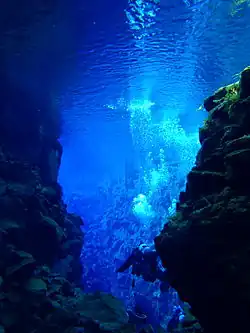
This itinerary is sorted by region, each of which generally takes at least one whole day to traverse. Travelling at a 'comfortably fast' pace and seeing the most famous attractions would require at least 6 days, due to many of them requiring a detour from the main road. Most tourists complete the loop in 1 or 2 weeks, which varies depending on time spent at attractions and how far they drive every day.
This route can be taken either in a clockwise or anti-clockwise direction. Most visitors prefer to go anti-clockwise to observe the presence of people diminishing as they get further from Reykjavik.
The Golden Circle
The Golden Circle at South Iceland, is doable as a day trip from Reykjavik, if one wants to stay there for another night. Though it essentially requires a far detour from Route 1, most visitors will begin the Ring Road trip with this loop for a teaser of what most of Iceland might look like. The itinerary for this day might be done as follows (clockwise with respect to the map) or in reverse, depending on where one wants to stay overnight.
Get to northbound Route 1 and exit at Route 36 to head to 🌍 Þingvellir National Park, where the natural and political history of Iceland converge. The Öxarárfoss waterfall is a short walk away from the entrance. As preposterous as it may sound, the waterfall was man-made in the 9th century by channeling the Öxará river into the ravine onto which the water falls, to provide water for the Icelandic parliament Althingi that convened there until the 18th century. Along the hiking trail to the waterfall is the Lögberg, where stacks of stones erected the speakers' throne of the Althingi. Following the path is the Drekkingarhylur, a former execution place for women who are accused of incest and infanticide, before the capital punishment decision was made by the monarch instead of the Althingi. A quaint little church stands on the path between P5 parking and Silfra diving site. Camping may be done at one of two campgrounds within the park for kr 1500 per person.
Drive along the lake, take the route 365 and then route 37 to route 35, which will lead to 🌍 Geysir on your left, the namesake of which is adopted into the English language for a hot steamy water spring that spouts upwards. Despite the namesake geyser not erupting periodically, its sister Strokkur is the Old Faithful of the two, with eruptions at the latest every 10 minutes and up to 20 m high. 🌍 Gullfoss, a gushing waterfall with two cascades, is just 10 minutes away on the same direction. The water flow is so powerful that it was considered as a site for a future hydroelectric plant, made famous by a long-lasting fight between investors and the property owner's daughter, who threatened to jump into the waterfall unless the plan was aborted. Campgrounds can be found in between these two attractions.
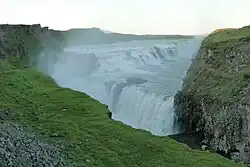
Getting down route 35 to the coast is Kerið. For kr 400, one can walk 55 m down the crater lake or walk around it. On sunny days, the aquamarine lake sleeps still below the red and black slopes peppered with lemon green grasses.
Back at the Ring Road, if one chooses to stay overnight, they may do so at Selfoss, one of the larger cities in the South at which the road passes through, or take a detour to the beach town of Eyrarbakki, or backtrack Reykjavik-bound to Hveragerði. If one follows this itinerary in reverse, one may stay back at Reykjavik and its suburbs, or if one is just beginning the ring road trip, take the Route 1 northbound to Akranes, one of the largest towns on the west shore.
Optionals
- The Geothermal Energy Exhibition is to the left of Route 1 at the junction to Hellisheiðarvirkjun. The exhibition is on the largest geothermal plants in the world. Geothermal energy produces all of Iceland's electricity and this place shows how heat from the earth can warm homes and foods, in addition to the mineral compositions in the volcanic ground where it stands. Open daily from 09:00 to 17:00, the admission price from kr 1755 includes a guided tour in English.
- Diving or snorkeling in Silfra inside the Þingvellir National Park, a fissure located along the crack that splits Iceland into two tectonic plates. Unlike the sea, it is done in a cold and perhaps the world's clearest freshwater, as the underwater spring is filtered by lava. As it is the location of past earthquakes, one would see formations of large basalt rocks at the bottom of the water, a result of slides triggered by them. Shallow at the entry points at the ends of the fissure, Silfra descends to a maximum depth of 63 m but diving to this depth is seldom done as it requires technical diving skills. Experienced divers only, per regulation of the National Park. kr 1500 for permit, obtainable at service office in the national park.
South
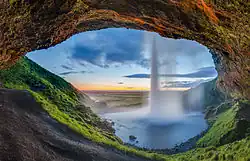
Some of the attractions in South Iceland are already covered in the Golden Circle section. This section explains the attractions stretching from Selfoss to the border of East Iceland. Areas down south are dominated by waterfalls and black sandy beaches, all of which are influenced by tectonic and volcanic activity that transforms complex topographies.
A one-hour journey eastbound from Selfoss is Seljalandfoss, another wonderful waterfall that is visible from Route 1. One can walk behind this 60 meter waterfall that overlooks the plains and coast, a favorite excursion spot during sunrise and any particular sunny day. Taking pictures can be at times difficult though because of the sprays. About a half hour ride down the road on your left, you will pass the Eyjafjallajökull, a seemingly small mountain whose eruption in 2010 successfully wreaked havoc thousands of flights within Europe for at least 1 week. Even if the volcano itself cannot be visited and is covered by a glacier, one may pull over to admire the towering rocky peaks surrounding it.
.jpg.webp)
Another short ride will take you to Skógafoss, a waterfall about the same height as Seljalandfoss but much bigger, where a rainbow or two is usually visible on sunny days. The flat bottom enables you to get close to the spray. The top of the waterfall used to be the coastline of Iceland; numerous past earthquakes have receded the coastline to the south of the ring road. A 1-day hike at the Fimmvörðuháls pass to the green Þórsmörk valley that passes the Eyjafjallajökull glacier would start here.
You will already be at the town of Skogar by this time. There are a couple of hotels, restaurants, and a campground, all in which you can rest. A museum and another waterfall can be visited (see below).
A 5-km detour to route 221 leads to Sólheimajökull, a glacier located between Eyjafjallajökull and Katla volcanoes. One can get close to or even stand on it (it's one of only two places in Iceland where you can do so), although paying for a guide is highly recommended for safety to get you far enough. The white ice has some black tints from volcanic material, spewed by both mountains. The infamous US Navy DC-3 Plane Wreck, which crashed in 1973, is at the black sand coast just after the junction to route 221, tucked far from the highway. As cars are not allowed to near this place, one may park at the designated lot on the side and walk one hour in each direction.
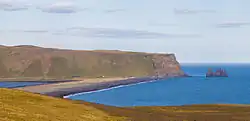
One can, however, still drive to the south beaches: Dyrhólaey, accessible from route 218, and Reynisfjara, reachable from route 215. The former has an over-the-hill view of glaciers and a lighthouse to the north and an arc at the beach seen from a hill, in between nesting birds during the summer. Its lower part is where one can walk the beach, though caution should be taken at anytime as the sneaky Atlantic waves are known to suck people to their deaths. The latter is known for its basalt sea stacks, a cave carved out of the same materials, and a panorama of giant rocks jutting out as an island.
The largest settlement in this section, Vik, is only minutes away from the aforementioned attractions. Despite the miniscule population, there are plenty of hotels and restaurants. Many tourists stay overnight here, where it's easier to buy the little things needed for the trip.
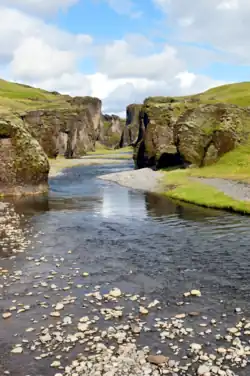
Continuing the journey, just after the junction to route 209, you will see multiple small cairns made from rocks on the left. This spot, named Laufskálavarða, is named as such because of an old tradition of wishing one good luck on a trip by building these cairns. Though taking pictures of them are fine, do not make a new one or move any!. Not long thereafter, a detour to route 206 leads to the Fjaðrárgljúfur, a 100m deep canyon in which one can look at it from either up the hill or from the river down the trail. Another 20 minutes down the road is the town of Kirkjubæjarklaustur. Accessible from the town is Systrafoss, a double waterfall whose water falls sloping instead of steeply.
Continue about 10 minutes to Foss á Síðu.There are little cascades right below the main falls, whose water would often instead shoot upwards if driven by the wind. One can only view this from afar, just a short detour from the highway. Not far to the right are two towering basalt columns called Dverghamrar.
Optionals
- The Landmannalaugar at the Fjallbak Nature Reserve is a geothermal hot spring and campsite, located in a mountainous section. Hiking or horse riding along many of its trails, which can take hours to days, take you to a breathtaking view of mountains with brownish smooth rocky slopes peppered with snow. Blahnukur is unique in that it also has bluish rocks. It is only open in summer and only 4x4 cars or select buses from Reykjavik are allowed to access this place.
- Skogar Folk Museum at the namesake city tells the civilization history of Iceland, including how they survive migrating and living here through the frequently rough nature. The exhibitions range from artifacts and sample building alongside its furniture, to transportation and telecommunication.
- An off-the-beaten-path Kvernufoss waterfall is a 20-minute hike away to the east of Skogar, accessible from the museum. One can walk behind it and they'll see the water cascading beneath the grassy hill.
- Just after Vik is Hjörleifshöfði, a large promontory which used to be inhabited. A 1 hour hike to the top offers vistas of both the mountain and the beach. It was a farm before the 1918 eruption of nearby Katla; what is left are now hills of rolling greens. One can get down to a short cave down the beach.
East

The main theme once one drives to the east is ice. Once one drives past Höfn, it gets less mountainous and the beaches are more hospitable than its western counterpart, with even ferries from Denmark docking there. One will also pass or drive through a couple of fjords.
The first point one passes as he enters the East are the Skaftafell' and Vatnajökull National Park. A left turn to route 998 will lead you to their joint ranger station and campground. This park expands all the way to north Iceland, but major highlights from its southern side include: hiking the Svínafellsjökull glacier that has been depicted in Hollywood films, going down the ice cave under the Vatnajökull glacier, Iceland's highest peak called the Hvannadalshnúkur, and the Jökulsárlón lagoon where perhaps the only iceberg complex outside the poles can be found. The adjacent Diamond Beach offers anyone to stand beneath the icebergs that are washed ashore. Many of those that are about to perish will be transparent just like the normal ice one uses for drinking, hence the diamond-like appearance. Sometimes seals can be seen on the icebergs. But at all times, do not attempt to climb them.
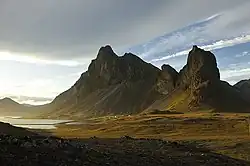
There are plenty of places to stay within the park, alongside the ring road. Höfn though, is a large town just one hour away.
Continuing the drive from Höfn, there is pretty much no settlements to see for the next hour. Just before the turn to the east part of the ring road, the Hvalnes beach and lighthouse has an awesome view of the beach with mountains one just passed in the background, sliding down to the sea. If lucky, the snowy caps of Vestrahorn and its adjacent mountains can also be visible.
The drive along the east coast is at times winding as one drives along fjords. The small village of Djúpivogur will be the first settlement one sees, perhaps after an hour's drive. Just after the Fossa Bridge, a road to the left leads to Nykurhylsfoss. A panorama picture should show the water from the falls flowing out to the adjacent sea. Going further up the hill is the Fossadalur campsite.
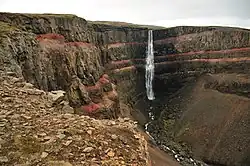
A recommended site that requires a detour is the Hengifoss waterfall, about 30 minutes from Egilsstaðir. A hike would take 2 hours one way, but on the way, one will see Litlanesfoss, which is surrounded by hexagonal basalt columns. The main waterfall, which is the third highest in Iceland, spews out water from layers of rock that sandwiches red clay in between. Once you're done with the visit, keep going on route 931 to Egilsstaðir, the largest town on East Iceland, through which route 1 passes.
Optionals
.jpg.webp)
- Attempt a detour just before the tunnel from Höfn get to Stokkness, where you get to see Vestrahorn, perhaps the most photographed mountain of Iceland. If lucky or skilled with photography techniques, the mountain is reflected onto the water. Unfortunately, it is one of the few places where you have to pay to see nature (kr 800 per person to be exact). Perhaps as a consolation, you can also check out its very own Cafe and a Viking village film set that never took off. To the right of Vestrahorn is Bunnhorn, also called the Batman Mountain because of its shape with three peaks that look like Batman’s logo.
- Seydisfjordur is a cute little town nestled in a fjord of the same name. It is known as a location in the Walter Mitty film. It is a port of call for ferries to Hirtshals, Denmark, for those that wish to follow the ring road from here. For that reason, there are a reasonable number of hotels. This requires a detour to Route 93 from just outside Egilsstaðir.
North
After Egilsstaðir however, route 1 no longer follows the coastline; those that want to do so may detour to Route 85, which meets Route 1 again a couple kilometers before Akureyri. The towns of interest, should you wish to stop by, are Húsavík and Raufarhöfn. The former, near the west end of Route 85, is known as a whale watching destination; the latter is the northernmost city in mainland Iceland. Perhaps the most significant nature feature to check out is Ásbyrgi, a horseshoe-shaped canyon cornered by 100 meter cliffs, believed in legend to be from one of the hooves from Odin's horse, Sleipnir.
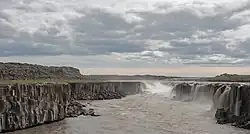
A right turn to route 862 will take you to the exclave of the Vatnajökull National Park. On that piece is Dettifoss, which despite the 'boring' landscape, is the most powerful falls in Europe. A short walk away is Selfoss (not to be confused with a town of the same name in South Iceland), with a somewhat better view overlooking the river and islands made of sediments.
Northeast Iceland is another active volcanic area, with craters you can hike onto and hot springs you can dip into. Hverir or Námaskarð is a large geothermal field with boiling water, hissing chimneys, and sulfur crystals in a Mars-like scenery. A hike on Námafjall gives you a broad view of the whole plain, yet it is an off-the-beaten-path spot. Just after its junction with Highway 87, on the left hand side is Mývatn, a large and serene volcanic lake with assorted natural beauties, namely craters you can hike onto and hot springs you can dip into. Game of Thrones aficionados might find Grjótagjá familiar but the hot spring under the cave will captivate other visitors as well, as the blue water displays its rays at the rocky ceiling. Reykjahlíð is the center of it all in this corner of Iceland, with the aforementioned attractions found before and after passing the town.
About an hour's drive after Mývatn is the Goðafoss complex, consisting of the namesake waterfall and the smaller Geitafoss. Although the Goðafoss is at a glance the same as Niagara Falls, it actually has four cascades. Its little counterpart, while itself looks less charming, offers an entirely different view because of the rock formations at the riverside.
In about one hour, you will arrive at Akureyri, the largest city of Iceland's northern half. Explore a little bit of town and stock up some food you couldn't find on your journey.
Once again, Route 1 does not follow the coastline until some point in West Iceland. The coastline will be on your north, which if you decide to go along, take route 82 that terminates at Ólafsfjörður and continue to route 76 that meets Route 1 at the other end. The rest of the routes along this area are mainly uneventful, except for a few towns in which one can take a break or fill up their fuel.
Optionals
- Dalvik at the north is another alternative destination for whale watching, which is closer to Akureyri. Practically the northern waters are ideal for the activity. It has a ferry that goes to Hrísey and Grimsey, the latter of which sits at the Arctic Circle.
West and the Westfjords
Although the west has wonderful fjords, they require a far detour from Route 1, which tourists would take anyway. For the West Fjords at northwest Iceland, take route 68 or 60. Access to Snæfellsjökull National Park and the Snæfellsnes Peninsula is through route 54, whose ends are at route 60 in the north and route 1 at the south. Route 1 would follow the coastline again at Borgarnes before passing the Hvalfjörður Tunnel, at which its end would only be 40 minutes away from Reykjavik. A long hike to Esjan gives you a panorama of the capital city and its bay.
Towns
National parks and lakes
Stay safe
While most, if not all of Highway 1 is passable in all conditions (given its status as an arterial road), those who intend to detour to see sights must check the latest weather and road conditions to see if they can actually be reached. Many attractions are closed and inaccessible throughout winter, or during bad weather. The latest weather and road conditions can be seen here.
If you plan on driving outside Route 1/the Ring Road, be sure to know what you are doing. Using under-equipped cars on bad roads can turn ugly very fast. Rental car companies also only allow you to drive mountain roads (F numbers) if you rent a 4x4 car suitable for these roads. Driving on F roads with a regular rental car is dangerous, and can result in substantial damage to the car as well as hefty fines by the rental company. Any off-road driving is strictly forbidden in Iceland.
- Highway Emergency, ☏ 112.
- Road conditions, ☏ +354 563-1500.
- Search and Rescue, ☏ +354 570-5900.
Go next
Being a ring road, there is no "beginning" or "end," but many worthwhile side trips are just off the ring towards the interior or coast. Signage is not always great and is usually in Icelandic so a good map and GPS come in handy.